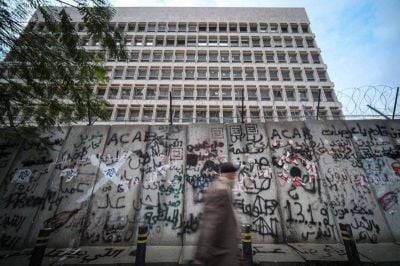
A 5-lollar bill designed by artist Tom Young and exhibited in Beirut. (Credit: Philippe Hage Boutros/L'Orient-Le Jour)
BEIRUT — Banque du Liban (BDL) on Wednesday published two circulars (No. 673 and No. 674) that relax or legitimize — depending on one's perspective — the banking restrictions applied to dollar accounts since the onset of Lebanon's economic crisis.
The first is an amendment to Circular No. 151, which authorized monthly withdrawals in Lebanese lira converted at the official rate of LL15,000 to the dollar for "bank dollars" or "lollars" — the nickname given to restricted foreign currency deposits.
The second amends Circular No. 158, which allows selected beneficiaries, according to precise terms and conditions, to withdraw $400 "fresh" and the equivalent in lira each month at the same fixed rate, which is far below the parallel market rate.
While BDL has only slightly modified circular No. 151, the changes made to No. 158 are far more substantial.
Circular No. 158: Lira portion no longer available
The first notable change to Circular No. 158 is that depositors who were benefiting from this scheme before July 1 can now withdraw only $400 "fresh" per month from eligible foreign currency amounts transferred from accounts blocked by banking restrictions. These depositors will be able to withdraw $4,800 over the 12 months following the same pivot date.
For new registrants, monthly withdrawals are now limited to $300, for a total of $3,600 over 12 months. Fresh dollars are those to which banks may not restrict access, in accordance with Circular No. 150 of April 2022, and whose value in lira is calculated based on the parallel market rate.
Holders of joint accounts eligible for the scheme will share the amounts withdrawn in proportion to their contribution to the account balance. To provide these "real dollars" to customers making withdrawals under Circular No. 158, banks are authorized to draw on the three percent of foreign currency liquidity they deposited in accounts with their correspondent banks abroad, provided they re-establish this ratio before Dec. 31, 2024.
The elimination of the $400 converted at the LL15,000 rate has two effects. First, it reduces the total amount that Circular No. 158 beneficiaries will be able to withdraw over the next 12 months. Second, it eliminates the haircut they had to suffer on the initial value of their deposit for each combined withdrawal under the old system, taking into account the difference between the official rate and the market rate.
Another indirect effect will be to control the money supply in pounds by limiting money injections into the market, which could prove particularly effective if BDL decides to increase the official rate again.
Circular No. 151: A questionable change
On the other hand, the BDL has made a few changes to the mechanism of Circular No. 151, through which the name "lollar" (a contraction of "Lebanese dollar") was popularized on social networks in the early months of the crisis. The conversion rate is still set at LL15,000 to the dollar, and the monthly limit is $1,600 per account.
In its new wording, the effects of Circular No. 151 have been extended for six months, until Dec. 31. The text also specifies that the beneficiary may be a person or legal entity, which was not included in the previous version.
The third change is more confusing: the BDL has removed the reference to the definition of fresh dollars originally set out in Circular No. 150 of April 9, 2020, and replaced it with that of a text that has already generated controversy since its publication: Circular No. 165 of April 19, 2023.
This text was published the day after a decision by the caretaker cabinet instructing BDL to "take compulsory and appropriate measures" to force banks to set uniform limits on withdrawals and transfers for all depositors. In particular, it explicitly recognized the distinction between fresh funds and blocked lollars, whereas the restrictions put in place by the banks had hitherto not been covered by any legal or regulatory text.
BDL did not explain why it had decided to replace the old definition of "fresh" with the new one in the updated version of Circular No. 151. The possibility that this was simply a technical change cannot be ruled out, nor can the risks that some bankers may have foreseen concerning the long-term repercussions and objectives of Circular No. 165.

